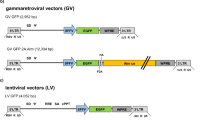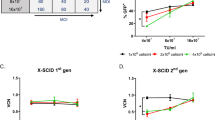Abstract
Gene therapy has proven to be of potential value for the correction of inherited hematopoietic disorders. However, the occurrence of severe side effects in some of the clinical trials has questioned the safety of this approach and has hampered the use of long terminal repeat-driven vectors for the treatment of a large number of patients. The development of self-inactivating (SIN) vectors with reduced genotoxicity provides an alternative to the currently used vectors. Our initial attempts to use SIN vectors for the correction of a myeloid disorder, chronic granulomatous disease, failed due to low vector titers and poor transgene expression. The optimization of the transgene cDNA (gp91phox) resulted in substantially increased titers and transgene expression. Most notably, transgene optimization significantly improved expression of a second cistron located downstream of gp91phox. Thus, optimization of the transgene sequence results in higher expression levels and increased therapeutic index allowing the use of low vector copy numbers per transduced cell and weaker internal promoters.
This is a preview of subscription content, access via your institution
Access options
Subscribe to this journal
Receive 12 print issues and online access
$259.00 per year
only $21.58 per issue
Buy this article
- Purchase on Springer Link
- Instant access to full article PDF
Prices may be subject to local taxes which are calculated during checkout




Similar content being viewed by others
References
Aiuti A, Slavin S, Aker M, Ficara F, Deola S, Mortellaro A et al. Correction of ADA-SCID by stem cell gene therapy combined with nonmyeloablative conditioning. Science 2002; 296: 2410–2413.
Cavazzana-Calvo M, Hacein-Bey S, de Saint Basile G, Gross F, Yvon E, Nusbaum P et al. Gene therapy of human severe combined immunodeficiency (SCID)-X1 disease. Science 2000; 288: 669–672.
Gaspar HB, Bjorkegren E, Parsley K, Gilmour KC, King D, Sinclair J et al. Successful reconstitution of immunity in ADA-SCID by stem cell gene therapy following cessation of PEG-ADA and use of mild preconditioning. Mol Ther 2006; 14: 505–513.
Gaspar HB, Parsley KL, Howe S, King D, Gilmour KC, Sinclair J et al. Gene therapy of X-linked severe combined immunodeficiency by use of a pseudotyped gammaretroviral vector. Lancet 2004; 364: 2181–2187.
Ott MG, Schmidt M, Schwarzwaelder K, Stein S, Siler U, Koehl U et al. Correction of X-linked chronic granulomatous disease by gene therapy, augmented by insertional activation of MDS1-EVI1, PRDM16 or SETBP1. Nat Med 2006; 12: 401–409.
Baum C, Dullmann J, Li Z, Fehse B, Meyer J, Williams DA et al. Side effects of retroviral gene transfer into hematopoietic stem cells. Blood 2003; 101: 2099–2114.
Baum C, Fehse B . Mutagenesis by retroviral transgene insertion: risk assessment and potential alternatives. Curr Opin Mol Ther 2003; 5: 458–462.
Baum C, Kustikova O, Modlich U, Li Z, Fehse B . Mutagenesis and oncogenesis by chromosomal insertion of gene transfer vectors. Hum Gene Ther 2006; 17: 253–263.
Baum C, von Kalle C, Staal FJ, Li Z, Fehse B, Schmidt M et al. Chance or necessity? Insertional mutagenesis in gene therapy and its consequences. Mol Ther 2004; 9: 5–13.
Cavazzana-Calvo M, Fischer A . Gene therapy for severe combined immunodeficiency: are we there yet? J Clin Invest 2007; 117: 1456–1465.
Hacein-Bey-Abina S, von Kalle C, Schmidt M, Le Deist F, Wulffraat N, McIntyre E et al. A serious adverse event after successful gene therapy for X-linked severe combined immunodeficiency. N Engl J Med 2003; 348: 255–256.
Hacein-Bey-Abina S, Von Kalle C, Schmidt M, McCormack MP, Wulffraat N, Leboulch P et al. LMO2-associated clonal T cell proliferation in two patients after gene therapy for SCID-X1. Science 2003; 302: 415–419.
McCormack MP, Rabbitts TH . Activation of the T-cell oncogene LMO2 after gene therapy for X-linked severe combined immunodeficiency. N Engl J Med 2004; 350: 913–922.
Heyworth PG, Cross AR, Curnutte JT . Chronic granulomatous disease. Curr Opin Immunol 2003; 15: 578–584.
Segal AW . The NADPH oxidase and chronic granulomatous disease. Mol Med Today 1996; 2: 129–135.
Segal BH, Leto TL, Gallin JI, Malech HL, Holland SM . Genetic, biochemical, and clinical features of chronic granulomatous disease. Medicine (Baltimore) 2000; 79: 170–200.
Anderson-Cohen M, Holland SM, Kuhns DB, Fleisher TA, Ding L, Brenner S et al. Severe phenotype of chronic granulomatous disease presenting in a female with a de novo mutation in gp91-phox and a non familial, extremely skewed X chromosome inactivation. Clin Immunol 2003; 109: 308–317.
Winkelstein JA, Marino MC, Johnston Jr RB, Boyle J, Curnutte J, Gallin JI et al. Chronic granulomatous disease. Report on a national registry of 368 patients. Medicine (Baltimore) 2000; 79: 155–169.
Naldini L . Inserting optimism into gene therapy. Nat Med 2006; 12: 386–388.
Schambach A, Mueller D, Galla M, Verstegen MM, Wagemaker G, Loew R et al. Overcoming promoter competition in packaging cells improves production of self-inactivating retroviral vectors. Gene Therapy 2006; 13: 1524–1533.
Zhen L, King AA, Xiao Y, Chanock SJ, Orkin SH, Dinauer MC . Gene targeting of X chromosome-linked chronic granulomatous disease locus in a human myeloid leukemia cell line and rescue by expression of recombinant gp91phox. Proc Natl Acad Sci USA 1993; 90: 9832–9836.
Mayo LA, Curnutte JT . Kinetic microplate assay for superoxide production by neutrophils and other phagocytic cells. Methods Enzymol 1990; 186: 567–575.
Kostic C, Chiodini F, Salmon P, Wiznerowicz M, Deglon N, Hornfeld D et al. Activity analysis of housekeeping promoters using self-inactivating lentiviral vector delivery into the mouse retina. Gene Therapy 2003; 10: 818–821.
Thornhill SI, Schambach A, Howe SJ, Ulaganathan M, Grassman E, Williams D et al. Self-inactivating gammaretroviral vectors for gene therapy of X-linked severe combined immunodeficiency. Mol Ther 2008; 16: 590–598.
Aiuti A, Cassani B, Andolfi G, Mirolo M, Biasco L, Recchia A et al. Multilineage hematopoietic reconstitution without clonal selection in ADA-SCID patients treated with stem cell gene therapy. J Clin Invest 2007; 117: 2233–2240.
Bushman FD . Retroviral integration and human gene therapy. J Clin Invest 2007; 117: 2083–2086.
Deichmann A, Hacein-Bey-Abina S, Schmidt M, Garrigue A, Brugman MH, Hu J et al. Vector integration is nonrandom and clustered and influences the fate of lymphopoiesis in SCID-X1 gene therapy. J Clin Invest 2007; 117: 2225–2232.
Schwarzwaelder K, Howe SJ, Schmidt M, Brugman MH, Deichmann A, Glimm H et al. Gammaretrovirus-mediated correction of SCID-X1 is associated with skewed vector integration site distribution in vivo. J Clin Invest 2007; 117: 2241–2249.
Du Y, Jenkins NA, Copeland NG . Insertional mutagenesis identifies genes that promote the immortalization of primary bone marrow progenitor cells. Blood 2005; 106: 3932–3939.
Kustikova OS, Geiger H, Li Z, Brugman MH, Chambers SM, Shaw CA et al. Retroviral vector insertion sites associated with dominant hematopoietic clones mark ‘stemness’ pathways. Blood 2007; 109: 1897–1907.
Metais JY, Dunbar CE . The MDS1-EVI1 gene complex as a retrovirus integration site: impact on behavior of hematopoietic cells and implications for gene therapy. Mol Ther 2008; 16: 439–449.
Modlich U, Kustikova OS, Schmidt M, Rudolph C, Meyer J, Li Z et al. Leukemias following retroviral transfer of multidrug resistance 1 (MDR1) are driven by combinatorial insertional mutagenesis. Blood 2005; 105: 4235–4246.
Emery DW, Yannaki E, Tubb J, Stamatoyannopoulos G . A chromatin insulator protects retrovirus vectors from chromosomal position effects. Proc Natl Acad Sci USA 2000; 97: 9150–9155.
Ryu BY, Evans-Galea MV, Gray JT, Bodine DM, Persons DA, Nienhuis AW . An experimental system for the evaluation of retroviral vector design to diminish the risk for proto-oncogene activation. Blood 2008; 111: 1866–1875.
Modlich U, Bohne J, Schmidt M, von Kalle C, Knoss S, Schambach A et al. Cell-culture assays reveal the importance of retroviral vector design for insertional genotoxicity. Blood 2006; 108: 2545–2553.
Zychlinski D, Schambach A, Modlich U, Maetzig T, Meyer J, Grassman E et al. Physiological promoters reduce the genotoxic risk of integrating gene vectors. Mol Ther 2008; 16: 718–725.
Montini E, Cesana D, Schmidt M, Sanvito F, Ponzoni M, Bartholomae C et al. Hematopoietic stem cell gene transfer in a tumor-prone mouse model uncovers low genotoxicity of lentiviral vector integration. Nat Biotechnol 2006; 24: 687–696.
Radcliffe PA, Sion CJ, Wilkes FJ, Custard EJ, Beard GL, Kingsman SM et al. Analysis of factor VIII mediated suppression of lentiviral vector titres. Gene Therapy 2008; 15: 289–297.
Wu Z, Sun J, Zhang T, Yin C, Yin F, Van Dyke T et al. Optimization of self-complementary AAV vectors for liver-directed expression results in sustained correction of hemophilia B at low vector dose. Mol Ther 2008; 16: 280–289.
Schambach A, Baum C . Vector design for expression of O6-methylguanine-DNA methyltransferase in hematopoietic cells. DNA Repair (Amst) 2007; 6: 1187–1196.
Choi U, DeRavin SS, Yamashita K, Whiting-Theobald N, Linton GF, Loktionova NA et al. Nuclear-localizing O6-benzylguanine-resistant GFP-MGMT fusion protein as a novel in vivo selection marker. Exp Hematol 2004; 32: 709–719.
Brenner S, Ryser MF, Choi U, Whiting-Theobald N, Kuhlisch E, Linton G et al. Polyclonal long-term MFGS-gp91phox marking in rhesus macaques after nonmyeloablative transplantation with transduced autologous peripheral blood progenitor cells. Mol Ther 2006; 14: 202–211.
Demaison C, Parsley K, Brouns G, Scherr M, Battmer K, Kinnon C et al. High-level transduction and gene expression in hematopoietic repopulating cells using a human immunodeficiency [correction of imunodeficiency] virus type 1-based lentiviral vector containing an internal spleen focus forming virus promoter. Hum Gene Ther 2002; 13: 803–813.
Nakamura M, Murakami M, Koga T, Tanaka Y, Minakami S . Monoclonal antibody 7D5 raised to cytochrome b558 of human neutrophils: immunocytochemical detection of the antigen in peripheral phagocytes of normal subjects, patients with chronic granulomatous disease, and their carrier mothers. Blood 1987; 69: 1404–1408.
Livak KJ, Schmittgen TD . Analysis of relative gene expression data using real-time quantitative PCR and the 2(−Delta Delta C(T)) method. Methods 2001; 25: 402–408.
Acknowledgements
This study was supported by grants from the CGD Research Trust (J4G/04B/GT) to MG and AJT, the Deutsche Forschungsgemeinschaft to SB (BR 2057/3-2), CB, AS and MG (SPP1230) and to CB and AS (excellence cluster REBIRTH) and from the Bundesministerium für Bildung und Forschung to CB, AS and MG (TreatID). AS was further supported by a personal stipend of the Else-Kröner Memorial Foundation. The Georg-Speyer-Haus is supported by the Bundesministerium für Gesundheit and the Hessisches Ministerium für Wissenschaft und Kunst.
Author information
Authors and Affiliations
Corresponding author
Additional information
Supplementary Information accompanies the paper on Gene Therapy website (http://www.nature.com/gt)
Supplementary information
Rights and permissions
About this article
Cite this article
Moreno-Carranza, B., Gentsch, M., Stein, S. et al. Transgene optimization significantly improves SIN vector titers, gp91phox expression and reconstitution of superoxide production in X-CGD cells. Gene Ther 16, 111–118 (2009). https://doi.org/10.1038/gt.2008.143
Received:
Revised:
Accepted:
Published:
Issue Date:
DOI: https://doi.org/10.1038/gt.2008.143
Keywords
This article is cited by
-
Correction of X-CGD patient HSPCs by targeted CYBB cDNA insertion using CRISPR/Cas9 with 53BP1 inhibition for enhanced homology-directed repair
Gene Therapy (2021)
-
Design of a regulated lentiviral vector for hematopoietic stem cell gene therapy of globoid cell leukodystrophy
Molecular Therapy - Methods & Clinical Development (2015)
-
Dual-regulated Lentiviral Vector for Gene Therapy of X-linked Chronic Granulomatosis
Molecular Therapy (2014)
-
Generation of X-CGD cells for vector evaluation from healthy donor CD34+ HSCs by shRNA-mediated knock down of gp91phox
Molecular Therapy - Methods & Clinical Development (2014)
-
Alpharetroviral Vector-mediated Gene Therapy for X-CGD: Functional Correction and Lack of Aberrant Splicing
Molecular Therapy (2013)



